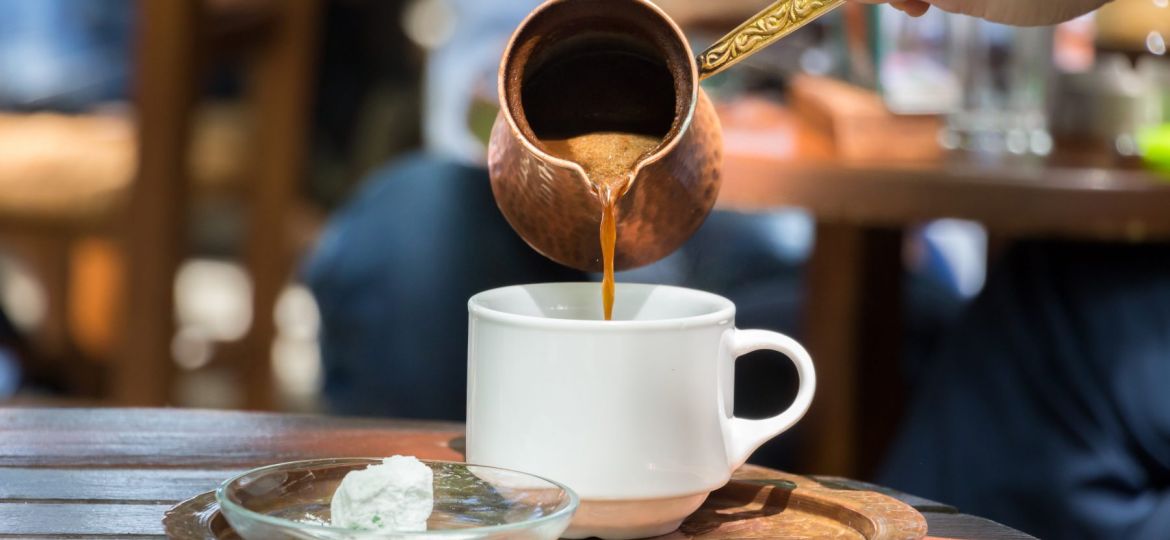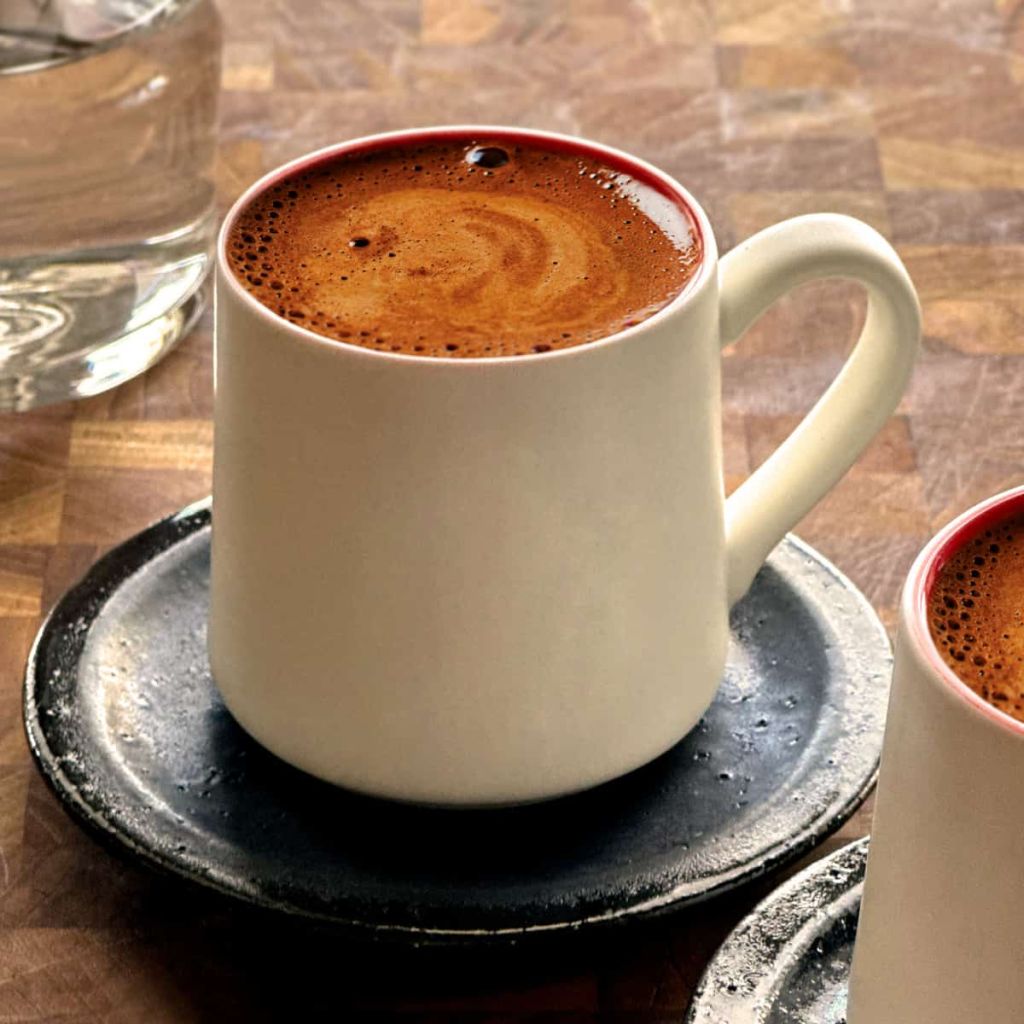
The traditional Greek coffee cup holds a rich history that dates back centuries. Its origins can be traced to the Ottoman Empire, during the reign of Sultan Suleiman the Magnificent in the 16th century.
As the empire expanded its reach, Turkish coffee was introduced to Greece. It quickly gained popularity and became an integral part of Greek culture.
The design of the Greek coffee cup is unique and distinguishable. It is typically small in size, with a handle-less cylindrical shape made of ceramic or porcelain.
What sets it apart is the thick-walled construction, which helps to retain the heat of the coffee. The cup’s narrow rim allows for sipping the coffee without burning the lips. The design has remained largely unchanged over the years, a testament to its timeless appeal.
Buy your Greek Coffee Cup now on Amazon!
Unique Features and Design of the Greek Coffee Cup
The Greek coffee cup, known as “souvlaki” or “tzitzaki,” is renowned for its unique features and design. This particular style of cup typically has a small, round shape with a handle. Its size allows for the perfect amount of coffee to be served, typically ranging from 2 to 4 ounces.
The distinctive design often includes intricate patterns and vibrant colors, making each cup a work of art in its own right.
One of the key features of the Greek coffee cup is its thick walls. This serves two purposes: to keep the coffee hot and to protect the drinker’s hands from the heat. Additionally, the cup often has a narrow opening, which helps to trap the aroma of the coffee, enhancing the overall drinking experience.
The handle, usually attached to one side of the cup, allows for easy grip and adds to the cup’s aesthetic appeal. These unique features and design elements make the Greek coffee cup a must-have item for coffee enthusiasts and collectors alike.
Buy your Greek Coffee Cup now on Amazon!

Traditional Greek Coffee Brewing Methods
To brew traditional Greek coffee, a specialized coffee pot called a briki is often used. The process begins by adding water to the briki and bringing it to a boil over low heat. Once boiling, finely-ground coffee is added to the pot, along with sugar according to personal preference.
The coffee is then stirred gently to ensure proper blending and dissolved sugar, before being left to simmer. The simmering process, which typically takes a few minutes, allows the flavors to fully develop and creates the distinct foam or “kaimaki” that is characteristic of Greek coffee.
Once the coffee has simmered and the foam has risen to the top of the briki, it is poured into small cups called “kafetieres.” Care must be taken to ensure that each cup receives an equal amount of foam.
Greek coffee is typically served alongside a glass of water, which is used to cleanse the palate before and after each sip. The coffee is then sipped slowly, allowing the rich flavors to be savored.
Cultural Significance and Symbolism of the Greek Coffee Cup
The traditional Greek coffee cup holds a significant cultural and symbolic value in Greek society. This iconic cup is not just a vessel for coffee but also a means of expressing cultural identity and hospitality. Its unique design and use in traditional Greek coffee ceremonies make it an integral part of Greek culture.
The Greek coffee cup, also known as a “tsipouro cup” or “demitasse cup,” is typically small in size with a narrow opening and a handle.
It is made of sturdy material, usually ceramic or porcelain, and is adorned with intricate patterns or motifs. This design not only enhances the aesthetic appeal but also serves practical purposes such as retaining heat and allowing for easy handling.
In Greek society, the act of drinking Greek coffee from these cups is more than just a daily routine. It holds symbolic meaning and is often associated with social interaction and connection.
The Greek coffee cup signifies hospitality, as it is a customary practice to offer a cup of coffee to guests as a warm welcome. It also embodies tradition and shared experiences, as the brewing and serving of Greek coffee often involves rituals and etiquette.
Overall, the Greek coffee cup represents the importance of community, connection, and cultural heritage in Greek society.
Buy your Greek Coffee Cup now on Amazon!
Rituals and Etiquette Surrounding Greek Coffee Drinking
In Greek culture, the act of drinking coffee is more than just a simple beverage. It is a social activity steeped in tradition and accompanied by specific rituals and etiquette. Before taking the first sip, it is customary for the host or the person who brewed the coffee to offer it to their guests first.
This gesture of hospitality is considered a sign of respect and friendship. It is also important to note that Greek coffee is traditionally served with a small glass of water on the side.
This is not meant to be drunk, but rather to cleanse the palate before enjoying the rich and robust flavors of the coffee.
Additionally, Greek coffee drinking follows a specific order. The youngest or the guest of honor is served first, while the oldest or the most esteemed person is served last.
This hierarchy is a reflection of Greek culture’s emphasis on respect for elders and the importance of age and wisdom. Moreover, when receiving the coffee cup, it is customary to hold it with two hands as a sign of appreciation and gratitude towards the person offering it.
It is also considered impolite to decline a cup of coffee, as it can be seen as a rejection of the offerer’s hospitality. Instead, it is customary to accept the cup and take at least a few sips, honoring the host’s generosity and effort.
Traditional Greek Coffee Cup Materials and Manufacturing Process
Traditional Greek coffee cups, also known as “tsoutsouros,” are typically made from ceramic or porcelain. These materials are preferred due to their ability to retain heat, keeping the coffee warm for a longer period of time.
The cups are often handcrafted, reflecting the artisans’ skill and attention to detail. The manufacturing process involves shaping the clay or porcelain into the desired cup shape, followed by firing it in a kiln to achieve durability and a smooth finish.
Sometimes, decorative elements are added to the cups, such as intricate patterns or vibrant colors, further enhancing their aesthetic appeal.
Apart from ceramic and porcelain, traditional Greek coffee cups can also be found in other materials like metal or glass, although these are less common. Metal cups, typically made from copper or brass, are known for their ornate designs and durability.
Glass cups, on the other hand, provide a unique visual experience as they allow the coffee’s rich, dark color to be admired. Regardless of the material used, the manufacturing process of these cups embodies the rich heritage and craftsmanship of Greek culture, making them not just functional vessels for coffee, but also pieces of art that hold cultural significance.
Buy your Greek Coffee Cup now on Amazon!
The Role of Greek Coffee Cups in Greek Cuisine and Hospitality
Greek coffee cups play a significant role in Greek cuisine and hospitality. These small cups, typically made of ceramic or porcelain, are specifically designed to enhance the coffee-drinking experience.
The unique shape and size of the cups allow the coffee to cool down slowly, preserving its rich flavors and aromas. Moreover, the cups are usually decorated with intricate designs and vibrant colors, adding an aesthetic appeal to the overall coffee-drinking experience.
In Greek culture, offering a cup of Greek coffee to guests is a symbol of hospitality and warmth. It is a tradition deeply rooted in Greek customs and traditions. When serving coffee in these cups, it is common for Greeks to accompany it with a small glass of water and a spoon.
The water serves as a palate cleanser, enabling the drinker to fully appreciate the flavors of the coffee. The spoon is used to stir the coffee and to indicate whether it has been consumed, as guests will place the spoon back in the cup when finished.
Overall, the Greek coffee cup holds immense cultural significance and is an integral part of Greek cuisine and hospitality. Its unique design, the rituals associated with it, and its intricate decorations make it not just a vessel for serving coffee, but a symbol of Greek culture and tradition.
Whether enjoyed in a traditional coffee shop or at home, the Greek coffee cup adds an element of authenticity and cultural richness to the coffee-drinking experience.
Greek Coffee Cup Art and Collectibles
Greek Coffee Cup Art and Collectibles showcase the rich cultural heritage and artistic traditions of Greece. These unique pieces reflect the country’s history and are highly valued by collectors and enthusiasts alike. Greek coffee cups often feature intricate designs, vibrant colors, and symbolic motifs that tell stories of Greek mythology, history, and daily life.
Crafted with great attention to detail, Greek coffee cups are made using various materials such as ceramic, porcelain, or even silver.
The manufacturing process involves skilled artisans who meticulously hand-paint or decorate each piece, ensuring their uniqueness and artistic value.
Collectors are particularly interested in cups with traditional patterns and motifs, as well as those created by renowned artists, which can fetch high prices in the market.
Greek Coffee Cup Art and Collectibles have become prized possessions for many individuals around the world.
These objects not only serve as functional coffee cups but also act as miniature works of art that encapsulate the spirit and beauty of Greek culture.
Whether displayed in homes or utilized during traditional coffee rituals, Greek coffee cups hold a special place in the hearts of those who admire their beauty and significance.
Buy your Greek Coffee Cup now on Amazon!
What are the origins of the traditional Greek coffee cup?
The traditional Greek coffee cup has its origins in Ottoman Turkish coffee culture.
What are the unique features and design of the Greek coffee cup?
Greek coffee cups are small, handle-less, and often decorated with intricate patterns.
How is traditional Greek coffee brewed?
Traditional Greek coffee is brewed by boiling finely ground coffee in a special pot called a briki.
What is the cultural significance and symbolism of the Greek coffee cup?
The Greek coffee cup represents friendship, hospitality, and conversation.
Are there any rituals or etiquette surrounding Greek coffee drinking?
Yes, there are specific rituals and etiquette associated with drinking Greek coffee, such as never stirring the coffee once it has been poured.
Buy your Greek Coffee Cup now on Amazon!
What materials are used in making traditional Greek coffee cups?
Traditional Greek coffee cups are typically made from ceramic or porcelain.
How are traditional Greek coffee cups manufactured?
Greek coffee cups are often handmade using traditional pottery techniques.
Read more about Product Review: Senseo Hamilton’s-Beach Commercial Deluxe Coffeemaker.
What role do Greek coffee cups play in Greek cuisine and hospitality?
Greek coffee cups are an essential part of Greek hospitality, often offered to guests as a sign of welcome and friendship.
Read more about Descaling Cuisinart Coffee Maker.
Is Greek coffee cup art collectible?
Yes, Greek coffee cup art is highly collectible, with unique designs and patterns sought after by collectors.









